Importance of Hygiene and Cleanliness in Food Safety
VerifiedAdded on 2020/07/23
|11
|2988
|51
AI Summary
The report highlights the crucial aspects of managing health and safety at workplaces, focusing on preventing food spoilage and disease. It emphasizes the significance of implementing proper hygiene practices within food systems, such as controlling pests and maintaining optimal temperatures. The study aims to evaluate various food safety management systems, including HACCP (Hazard Analysis and Critical Control Points), to ensure compliance with regulations like the Food Safety Regulation 2004 and the General Food Regulation 2004.
Contribute Materials
Your contribution can guide someone’s learning journey. Share your
documents today.
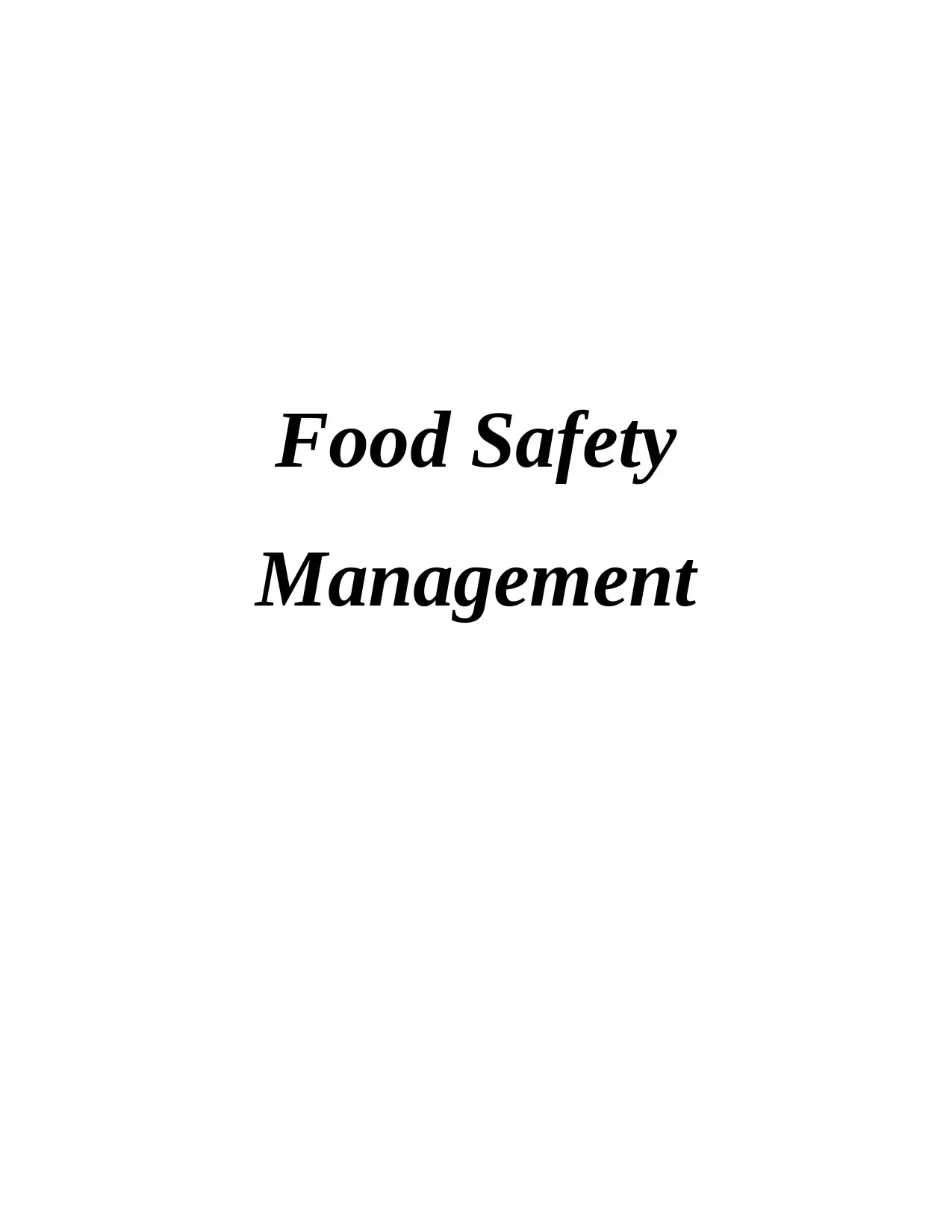
Food Safety
Management
Management
Secure Best Marks with AI Grader
Need help grading? Try our AI Grader for instant feedback on your assignments.
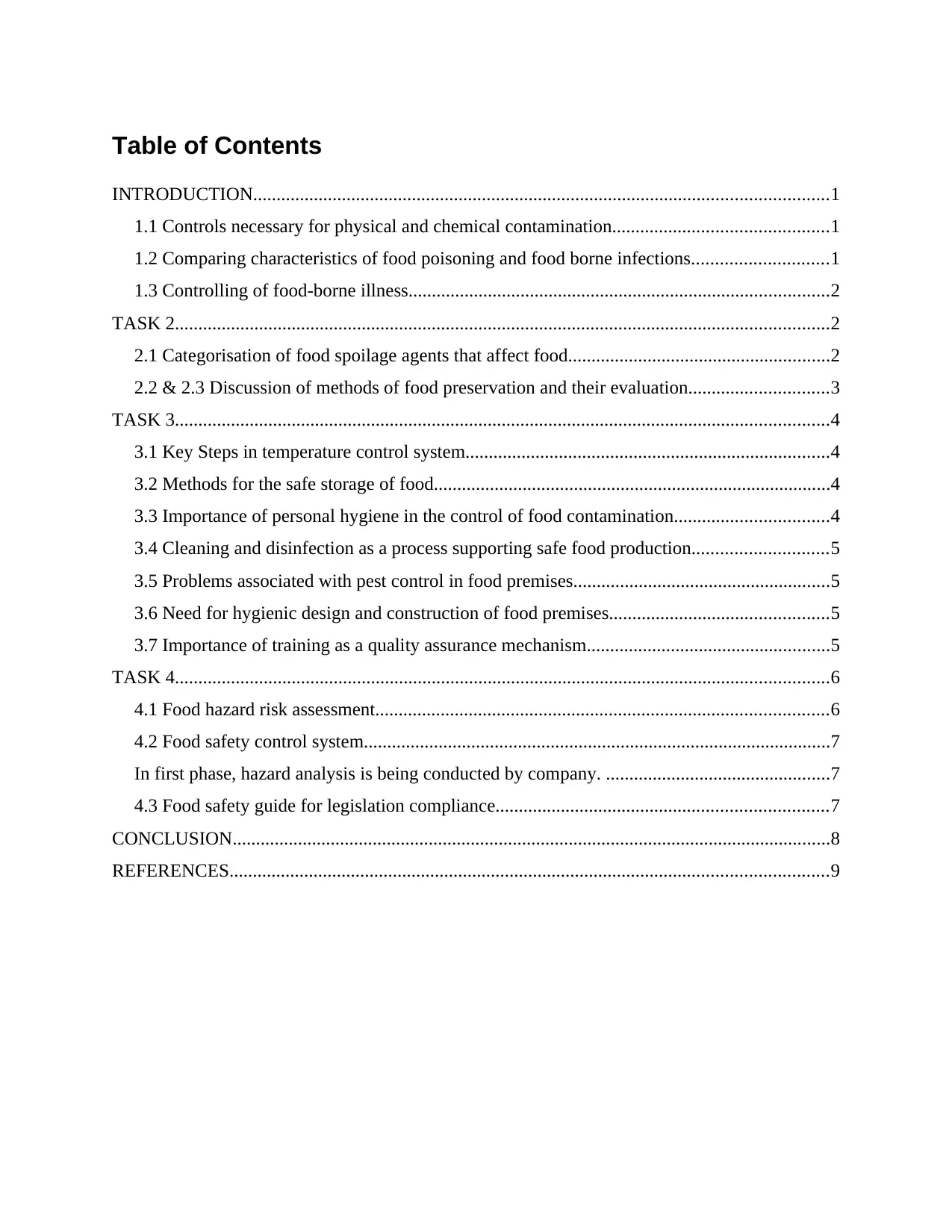
Table of Contents
INTRODUCTION...........................................................................................................................1
1.1 Controls necessary for physical and chemical contamination..............................................1
1.2 Comparing characteristics of food poisoning and food borne infections.............................1
1.3 Controlling of food-borne illness..........................................................................................2
TASK 2............................................................................................................................................2
2.1 Categorisation of food spoilage agents that affect food........................................................2
2.2 & 2.3 Discussion of methods of food preservation and their evaluation..............................3
TASK 3............................................................................................................................................4
3.1 Key Steps in temperature control system..............................................................................4
3.2 Methods for the safe storage of food.....................................................................................4
3.3 Importance of personal hygiene in the control of food contamination.................................4
3.4 Cleaning and disinfection as a process supporting safe food production.............................5
3.5 Problems associated with pest control in food premises.......................................................5
3.6 Need for hygienic design and construction of food premises...............................................5
3.7 Importance of training as a quality assurance mechanism....................................................5
TASK 4............................................................................................................................................6
4.1 Food hazard risk assessment.................................................................................................6
4.2 Food safety control system....................................................................................................7
In first phase, hazard analysis is being conducted by company. ................................................7
4.3 Food safety guide for legislation compliance.......................................................................7
CONCLUSION................................................................................................................................8
REFERENCES................................................................................................................................9
INTRODUCTION...........................................................................................................................1
1.1 Controls necessary for physical and chemical contamination..............................................1
1.2 Comparing characteristics of food poisoning and food borne infections.............................1
1.3 Controlling of food-borne illness..........................................................................................2
TASK 2............................................................................................................................................2
2.1 Categorisation of food spoilage agents that affect food........................................................2
2.2 & 2.3 Discussion of methods of food preservation and their evaluation..............................3
TASK 3............................................................................................................................................4
3.1 Key Steps in temperature control system..............................................................................4
3.2 Methods for the safe storage of food.....................................................................................4
3.3 Importance of personal hygiene in the control of food contamination.................................4
3.4 Cleaning and disinfection as a process supporting safe food production.............................5
3.5 Problems associated with pest control in food premises.......................................................5
3.6 Need for hygienic design and construction of food premises...............................................5
3.7 Importance of training as a quality assurance mechanism....................................................5
TASK 4............................................................................................................................................6
4.1 Food hazard risk assessment.................................................................................................6
4.2 Food safety control system....................................................................................................7
In first phase, hazard analysis is being conducted by company. ................................................7
4.3 Food safety guide for legislation compliance.......................................................................7
CONCLUSION................................................................................................................................8
REFERENCES................................................................................................................................9
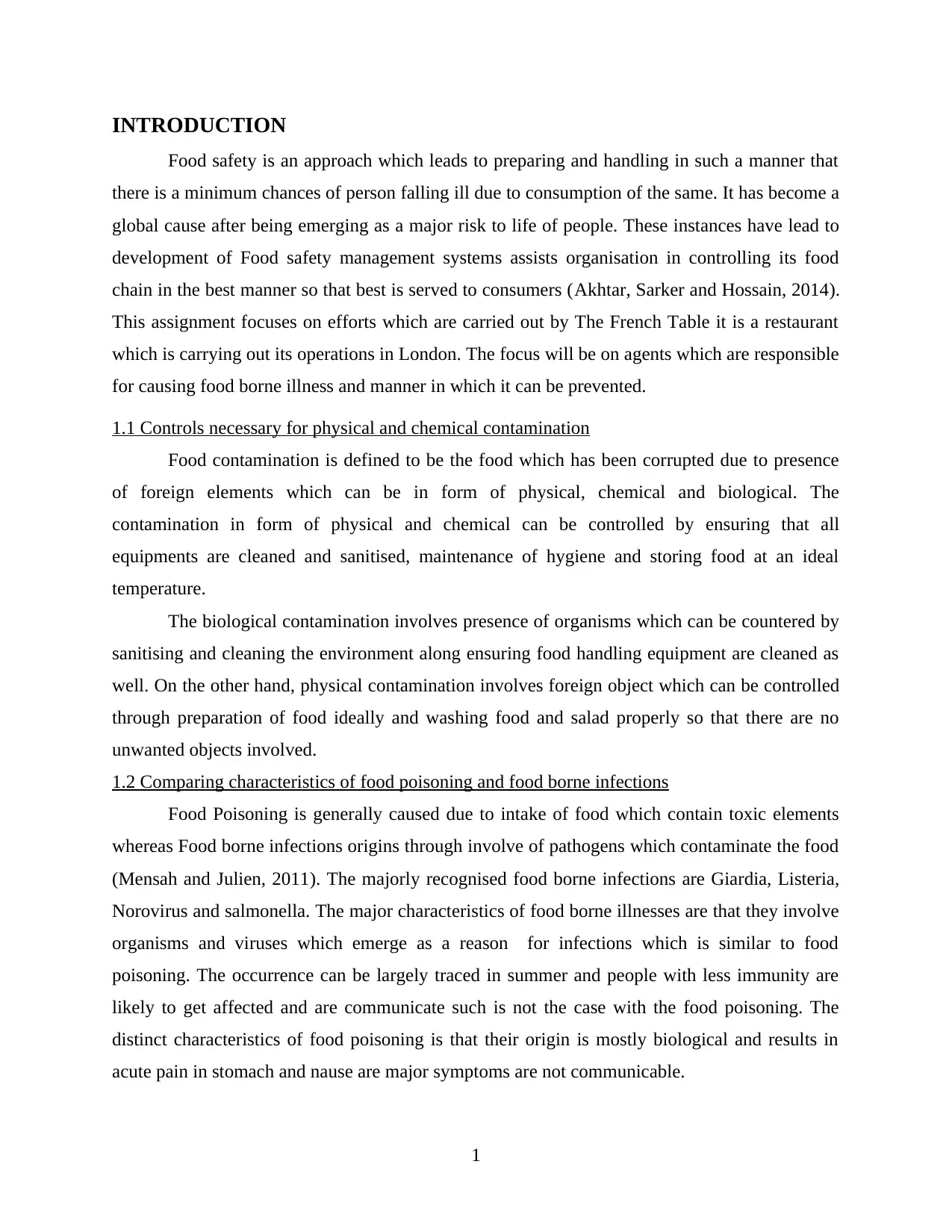
INTRODUCTION
Food safety is an approach which leads to preparing and handling in such a manner that
there is a minimum chances of person falling ill due to consumption of the same. It has become a
global cause after being emerging as a major risk to life of people. These instances have lead to
development of Food safety management systems assists organisation in controlling its food
chain in the best manner so that best is served to consumers (Akhtar, Sarker and Hossain, 2014).
This assignment focuses on efforts which are carried out by The French Table it is a restaurant
which is carrying out its operations in London. The focus will be on agents which are responsible
for causing food borne illness and manner in which it can be prevented.
1.1 Controls necessary for physical and chemical contamination
Food contamination is defined to be the food which has been corrupted due to presence
of foreign elements which can be in form of physical, chemical and biological. The
contamination in form of physical and chemical can be controlled by ensuring that all
equipments are cleaned and sanitised, maintenance of hygiene and storing food at an ideal
temperature.
The biological contamination involves presence of organisms which can be countered by
sanitising and cleaning the environment along ensuring food handling equipment are cleaned as
well. On the other hand, physical contamination involves foreign object which can be controlled
through preparation of food ideally and washing food and salad properly so that there are no
unwanted objects involved.
1.2 Comparing characteristics of food poisoning and food borne infections
Food Poisoning is generally caused due to intake of food which contain toxic elements
whereas Food borne infections origins through involve of pathogens which contaminate the food
(Mensah and Julien, 2011). The majorly recognised food borne infections are Giardia, Listeria,
Norovirus and salmonella. The major characteristics of food borne illnesses are that they involve
organisms and viruses which emerge as a reason for infections which is similar to food
poisoning. The occurrence can be largely traced in summer and people with less immunity are
likely to get affected and are communicate such is not the case with the food poisoning. The
distinct characteristics of food poisoning is that their origin is mostly biological and results in
acute pain in stomach and nause are major symptoms are not communicable.
1
Food safety is an approach which leads to preparing and handling in such a manner that
there is a minimum chances of person falling ill due to consumption of the same. It has become a
global cause after being emerging as a major risk to life of people. These instances have lead to
development of Food safety management systems assists organisation in controlling its food
chain in the best manner so that best is served to consumers (Akhtar, Sarker and Hossain, 2014).
This assignment focuses on efforts which are carried out by The French Table it is a restaurant
which is carrying out its operations in London. The focus will be on agents which are responsible
for causing food borne illness and manner in which it can be prevented.
1.1 Controls necessary for physical and chemical contamination
Food contamination is defined to be the food which has been corrupted due to presence
of foreign elements which can be in form of physical, chemical and biological. The
contamination in form of physical and chemical can be controlled by ensuring that all
equipments are cleaned and sanitised, maintenance of hygiene and storing food at an ideal
temperature.
The biological contamination involves presence of organisms which can be countered by
sanitising and cleaning the environment along ensuring food handling equipment are cleaned as
well. On the other hand, physical contamination involves foreign object which can be controlled
through preparation of food ideally and washing food and salad properly so that there are no
unwanted objects involved.
1.2 Comparing characteristics of food poisoning and food borne infections
Food Poisoning is generally caused due to intake of food which contain toxic elements
whereas Food borne infections origins through involve of pathogens which contaminate the food
(Mensah and Julien, 2011). The majorly recognised food borne infections are Giardia, Listeria,
Norovirus and salmonella. The major characteristics of food borne illnesses are that they involve
organisms and viruses which emerge as a reason for infections which is similar to food
poisoning. The occurrence can be largely traced in summer and people with less immunity are
likely to get affected and are communicate such is not the case with the food poisoning. The
distinct characteristics of food poisoning is that their origin is mostly biological and results in
acute pain in stomach and nause are major symptoms are not communicable.
1
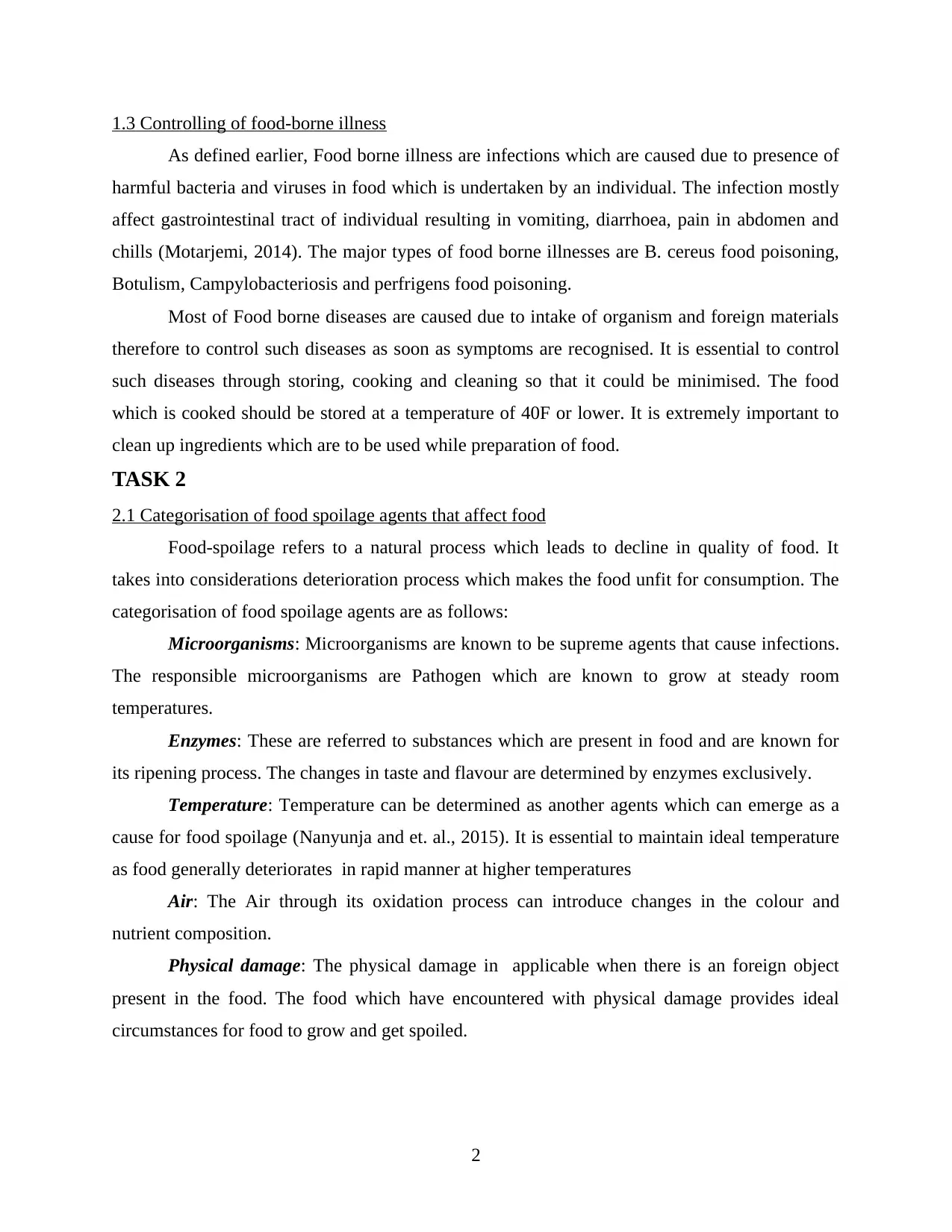
1.3 Controlling of food-borne illness
As defined earlier, Food borne illness are infections which are caused due to presence of
harmful bacteria and viruses in food which is undertaken by an individual. The infection mostly
affect gastrointestinal tract of individual resulting in vomiting, diarrhoea, pain in abdomen and
chills (Motarjemi, 2014). The major types of food borne illnesses are B. cereus food poisoning,
Botulism, Campylobacteriosis and perfrigens food poisoning.
Most of Food borne diseases are caused due to intake of organism and foreign materials
therefore to control such diseases as soon as symptoms are recognised. It is essential to control
such diseases through storing, cooking and cleaning so that it could be minimised. The food
which is cooked should be stored at a temperature of 40F or lower. It is extremely important to
clean up ingredients which are to be used while preparation of food.
TASK 2
2.1 Categorisation of food spoilage agents that affect food
Food-spoilage refers to a natural process which leads to decline in quality of food. It
takes into considerations deterioration process which makes the food unfit for consumption. The
categorisation of food spoilage agents are as follows:
Microorganisms: Microorganisms are known to be supreme agents that cause infections.
The responsible microorganisms are Pathogen which are known to grow at steady room
temperatures.
Enzymes: These are referred to substances which are present in food and are known for
its ripening process. The changes in taste and flavour are determined by enzymes exclusively.
Temperature: Temperature can be determined as another agents which can emerge as a
cause for food spoilage (Nanyunja and et. al., 2015). It is essential to maintain ideal temperature
as food generally deteriorates in rapid manner at higher temperatures
Air: The Air through its oxidation process can introduce changes in the colour and
nutrient composition.
Physical damage: The physical damage in applicable when there is an foreign object
present in the food. The food which have encountered with physical damage provides ideal
circumstances for food to grow and get spoiled.
2
As defined earlier, Food borne illness are infections which are caused due to presence of
harmful bacteria and viruses in food which is undertaken by an individual. The infection mostly
affect gastrointestinal tract of individual resulting in vomiting, diarrhoea, pain in abdomen and
chills (Motarjemi, 2014). The major types of food borne illnesses are B. cereus food poisoning,
Botulism, Campylobacteriosis and perfrigens food poisoning.
Most of Food borne diseases are caused due to intake of organism and foreign materials
therefore to control such diseases as soon as symptoms are recognised. It is essential to control
such diseases through storing, cooking and cleaning so that it could be minimised. The food
which is cooked should be stored at a temperature of 40F or lower. It is extremely important to
clean up ingredients which are to be used while preparation of food.
TASK 2
2.1 Categorisation of food spoilage agents that affect food
Food-spoilage refers to a natural process which leads to decline in quality of food. It
takes into considerations deterioration process which makes the food unfit for consumption. The
categorisation of food spoilage agents are as follows:
Microorganisms: Microorganisms are known to be supreme agents that cause infections.
The responsible microorganisms are Pathogen which are known to grow at steady room
temperatures.
Enzymes: These are referred to substances which are present in food and are known for
its ripening process. The changes in taste and flavour are determined by enzymes exclusively.
Temperature: Temperature can be determined as another agents which can emerge as a
cause for food spoilage (Nanyunja and et. al., 2015). It is essential to maintain ideal temperature
as food generally deteriorates in rapid manner at higher temperatures
Air: The Air through its oxidation process can introduce changes in the colour and
nutrient composition.
Physical damage: The physical damage in applicable when there is an foreign object
present in the food. The food which have encountered with physical damage provides ideal
circumstances for food to grow and get spoiled.
2
Secure Best Marks with AI Grader
Need help grading? Try our AI Grader for instant feedback on your assignments.
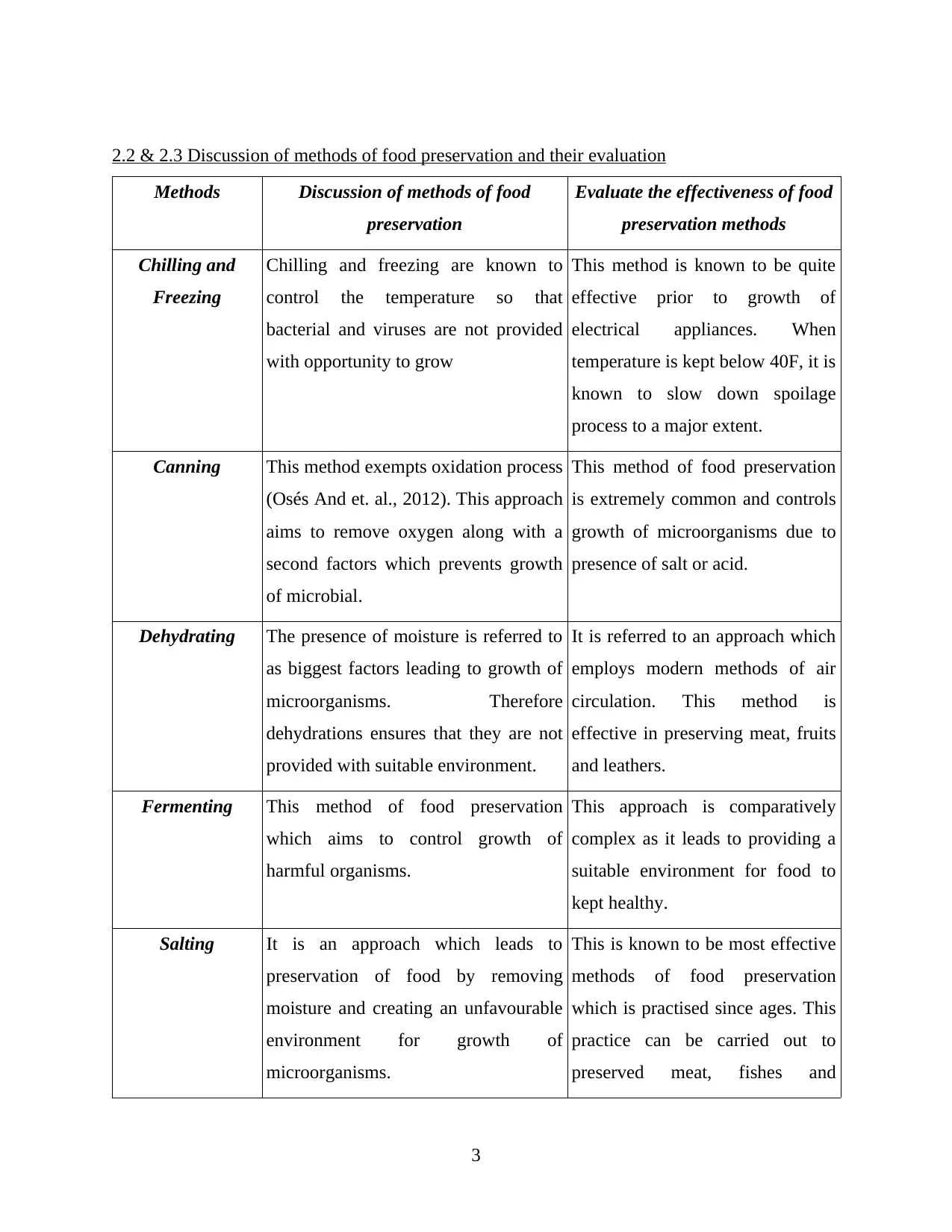
2.2 & 2.3 Discussion of methods of food preservation and their evaluation
Methods Discussion of methods of food
preservation
Evaluate the effectiveness of food
preservation methods
Chilling and
Freezing
Chilling and freezing are known to
control the temperature so that
bacterial and viruses are not provided
with opportunity to grow
This method is known to be quite
effective prior to growth of
electrical appliances. When
temperature is kept below 40F, it is
known to slow down spoilage
process to a major extent.
Canning This method exempts oxidation process
(Osés And et. al., 2012). This approach
aims to remove oxygen along with a
second factors which prevents growth
of microbial.
This method of food preservation
is extremely common and controls
growth of microorganisms due to
presence of salt or acid.
Dehydrating The presence of moisture is referred to
as biggest factors leading to growth of
microorganisms. Therefore
dehydrations ensures that they are not
provided with suitable environment.
It is referred to an approach which
employs modern methods of air
circulation. This method is
effective in preserving meat, fruits
and leathers.
Fermenting This method of food preservation
which aims to control growth of
harmful organisms.
This approach is comparatively
complex as it leads to providing a
suitable environment for food to
kept healthy.
Salting It is an approach which leads to
preservation of food by removing
moisture and creating an unfavourable
environment for growth of
microorganisms.
This is known to be most effective
methods of food preservation
which is practised since ages. This
practice can be carried out to
preserved meat, fishes and
3
Methods Discussion of methods of food
preservation
Evaluate the effectiveness of food
preservation methods
Chilling and
Freezing
Chilling and freezing are known to
control the temperature so that
bacterial and viruses are not provided
with opportunity to grow
This method is known to be quite
effective prior to growth of
electrical appliances. When
temperature is kept below 40F, it is
known to slow down spoilage
process to a major extent.
Canning This method exempts oxidation process
(Osés And et. al., 2012). This approach
aims to remove oxygen along with a
second factors which prevents growth
of microbial.
This method of food preservation
is extremely common and controls
growth of microorganisms due to
presence of salt or acid.
Dehydrating The presence of moisture is referred to
as biggest factors leading to growth of
microorganisms. Therefore
dehydrations ensures that they are not
provided with suitable environment.
It is referred to an approach which
employs modern methods of air
circulation. This method is
effective in preserving meat, fruits
and leathers.
Fermenting This method of food preservation
which aims to control growth of
harmful organisms.
This approach is comparatively
complex as it leads to providing a
suitable environment for food to
kept healthy.
Salting It is an approach which leads to
preservation of food by removing
moisture and creating an unfavourable
environment for growth of
microorganisms.
This is known to be most effective
methods of food preservation
which is practised since ages. This
practice can be carried out to
preserved meat, fishes and
3
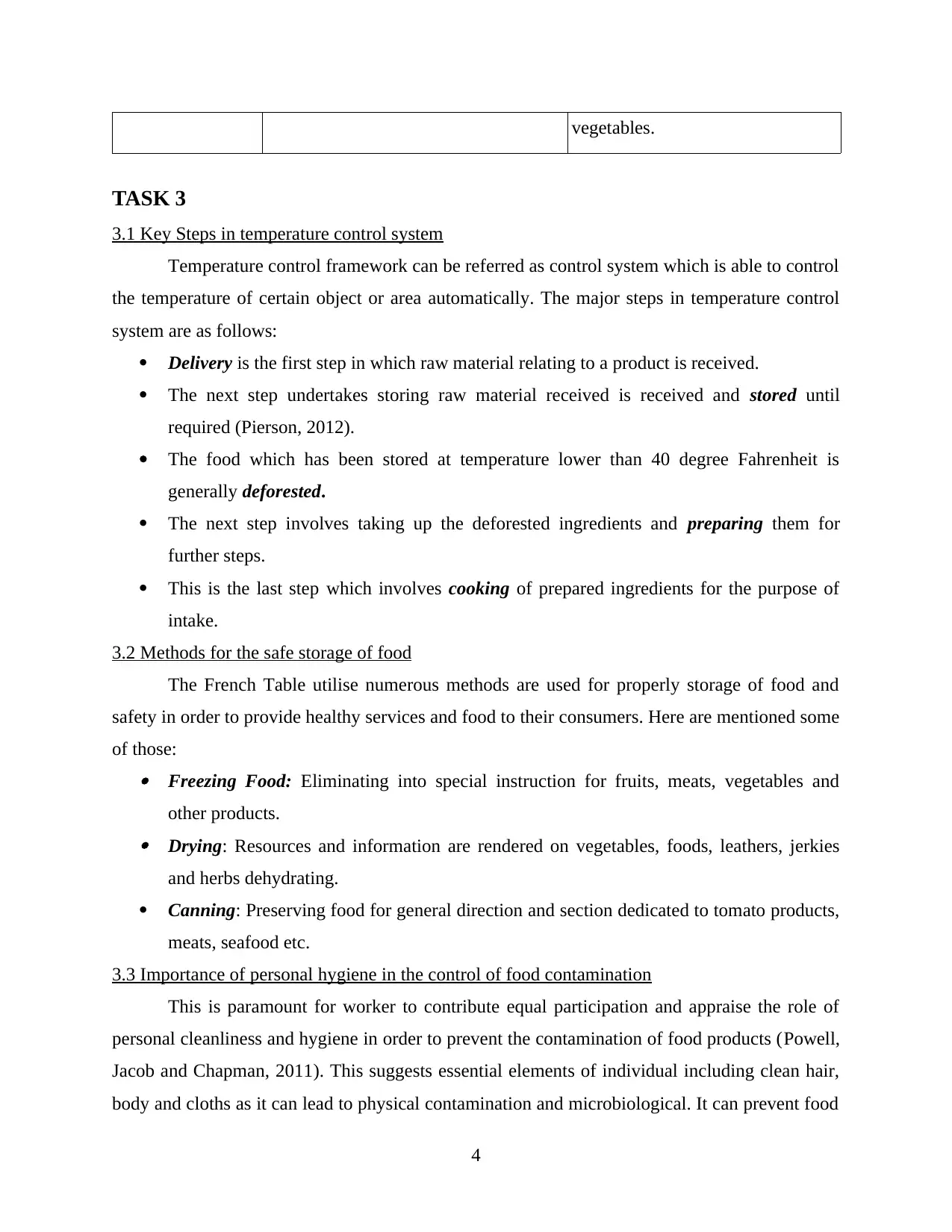
vegetables.
TASK 3
3.1 Key Steps in temperature control system
Temperature control framework can be referred as control system which is able to control
the temperature of certain object or area automatically. The major steps in temperature control
system are as follows:
Delivery is the first step in which raw material relating to a product is received.
The next step undertakes storing raw material received is received and stored until
required (Pierson, 2012).
The food which has been stored at temperature lower than 40 degree Fahrenheit is
generally deforested.
The next step involves taking up the deforested ingredients and preparing them for
further steps.
This is the last step which involves cooking of prepared ingredients for the purpose of
intake.
3.2 Methods for the safe storage of food
The French Table utilise numerous methods are used for properly storage of food and
safety in order to provide healthy services and food to their consumers. Here are mentioned some
of those: Freezing Food: Eliminating into special instruction for fruits, meats, vegetables and
other products. Drying: Resources and information are rendered on vegetables, foods, leathers, jerkies
and herbs dehydrating.
Canning: Preserving food for general direction and section dedicated to tomato products,
meats, seafood etc.
3.3 Importance of personal hygiene in the control of food contamination
This is paramount for worker to contribute equal participation and appraise the role of
personal cleanliness and hygiene in order to prevent the contamination of food products (Powell,
Jacob and Chapman, 2011). This suggests essential elements of individual including clean hair,
body and cloths as it can lead to physical contamination and microbiological. It can prevent food
4
TASK 3
3.1 Key Steps in temperature control system
Temperature control framework can be referred as control system which is able to control
the temperature of certain object or area automatically. The major steps in temperature control
system are as follows:
Delivery is the first step in which raw material relating to a product is received.
The next step undertakes storing raw material received is received and stored until
required (Pierson, 2012).
The food which has been stored at temperature lower than 40 degree Fahrenheit is
generally deforested.
The next step involves taking up the deforested ingredients and preparing them for
further steps.
This is the last step which involves cooking of prepared ingredients for the purpose of
intake.
3.2 Methods for the safe storage of food
The French Table utilise numerous methods are used for properly storage of food and
safety in order to provide healthy services and food to their consumers. Here are mentioned some
of those: Freezing Food: Eliminating into special instruction for fruits, meats, vegetables and
other products. Drying: Resources and information are rendered on vegetables, foods, leathers, jerkies
and herbs dehydrating.
Canning: Preserving food for general direction and section dedicated to tomato products,
meats, seafood etc.
3.3 Importance of personal hygiene in the control of food contamination
This is paramount for worker to contribute equal participation and appraise the role of
personal cleanliness and hygiene in order to prevent the contamination of food products (Powell,
Jacob and Chapman, 2011). This suggests essential elements of individual including clean hair,
body and cloths as it can lead to physical contamination and microbiological. It can prevent food
4
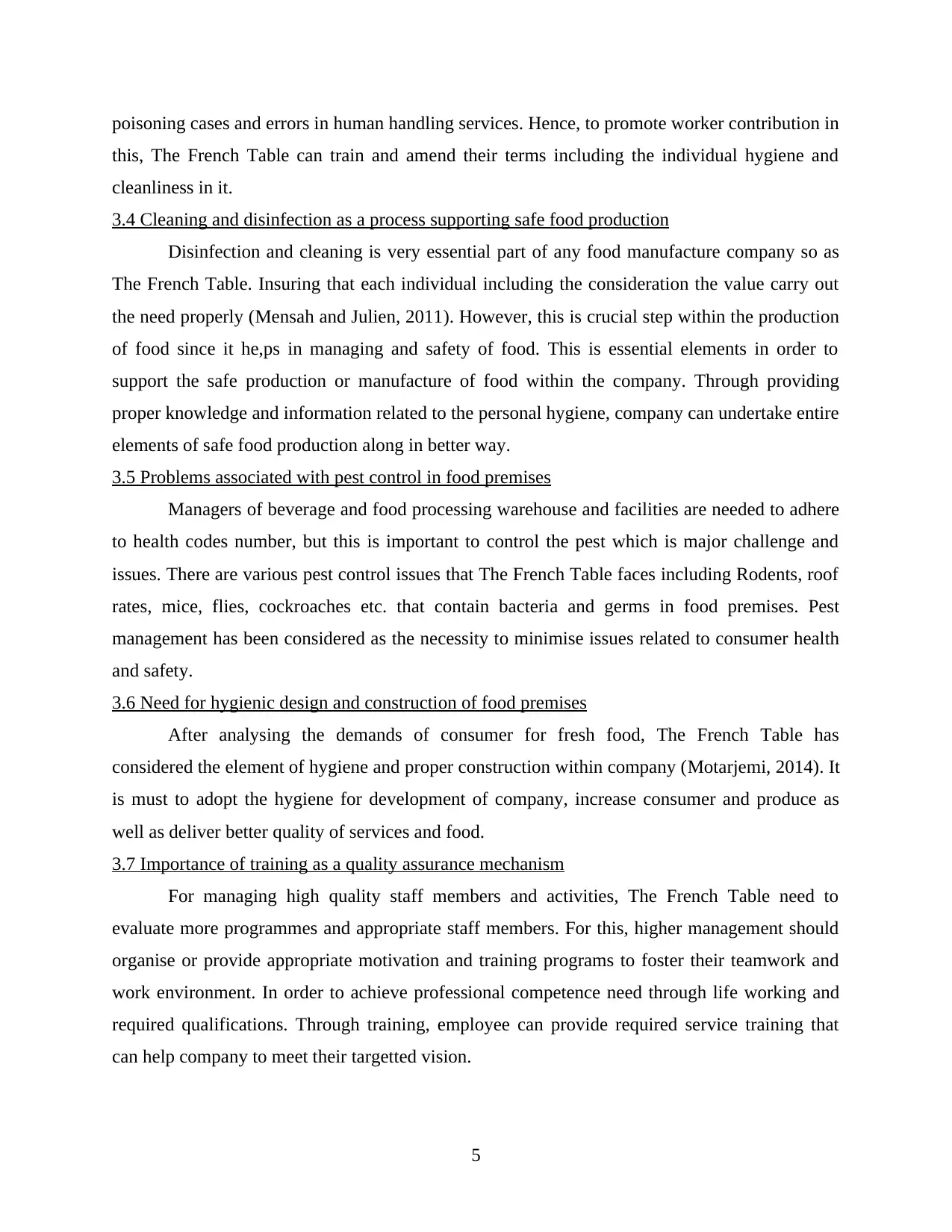
poisoning cases and errors in human handling services. Hence, to promote worker contribution in
this, The French Table can train and amend their terms including the individual hygiene and
cleanliness in it.
3.4 Cleaning and disinfection as a process supporting safe food production
Disinfection and cleaning is very essential part of any food manufacture company so as
The French Table. Insuring that each individual including the consideration the value carry out
the need properly (Mensah and Julien, 2011). However, this is crucial step within the production
of food since it he,ps in managing and safety of food. This is essential elements in order to
support the safe production or manufacture of food within the company. Through providing
proper knowledge and information related to the personal hygiene, company can undertake entire
elements of safe food production along in better way.
3.5 Problems associated with pest control in food premises
Managers of beverage and food processing warehouse and facilities are needed to adhere
to health codes number, but this is important to control the pest which is major challenge and
issues. There are various pest control issues that The French Table faces including Rodents, roof
rates, mice, flies, cockroaches etc. that contain bacteria and germs in food premises. Pest
management has been considered as the necessity to minimise issues related to consumer health
and safety.
3.6 Need for hygienic design and construction of food premises
After analysing the demands of consumer for fresh food, The French Table has
considered the element of hygiene and proper construction within company (Motarjemi, 2014). It
is must to adopt the hygiene for development of company, increase consumer and produce as
well as deliver better quality of services and food.
3.7 Importance of training as a quality assurance mechanism
For managing high quality staff members and activities, The French Table need to
evaluate more programmes and appropriate staff members. For this, higher management should
organise or provide appropriate motivation and training programs to foster their teamwork and
work environment. In order to achieve professional competence need through life working and
required qualifications. Through training, employee can provide required service training that
can help company to meet their targetted vision.
5
this, The French Table can train and amend their terms including the individual hygiene and
cleanliness in it.
3.4 Cleaning and disinfection as a process supporting safe food production
Disinfection and cleaning is very essential part of any food manufacture company so as
The French Table. Insuring that each individual including the consideration the value carry out
the need properly (Mensah and Julien, 2011). However, this is crucial step within the production
of food since it he,ps in managing and safety of food. This is essential elements in order to
support the safe production or manufacture of food within the company. Through providing
proper knowledge and information related to the personal hygiene, company can undertake entire
elements of safe food production along in better way.
3.5 Problems associated with pest control in food premises
Managers of beverage and food processing warehouse and facilities are needed to adhere
to health codes number, but this is important to control the pest which is major challenge and
issues. There are various pest control issues that The French Table faces including Rodents, roof
rates, mice, flies, cockroaches etc. that contain bacteria and germs in food premises. Pest
management has been considered as the necessity to minimise issues related to consumer health
and safety.
3.6 Need for hygienic design and construction of food premises
After analysing the demands of consumer for fresh food, The French Table has
considered the element of hygiene and proper construction within company (Motarjemi, 2014). It
is must to adopt the hygiene for development of company, increase consumer and produce as
well as deliver better quality of services and food.
3.7 Importance of training as a quality assurance mechanism
For managing high quality staff members and activities, The French Table need to
evaluate more programmes and appropriate staff members. For this, higher management should
organise or provide appropriate motivation and training programs to foster their teamwork and
work environment. In order to achieve professional competence need through life working and
required qualifications. Through training, employee can provide required service training that
can help company to meet their targetted vision.
5
Paraphrase This Document
Need a fresh take? Get an instant paraphrase of this document with our AI Paraphraser
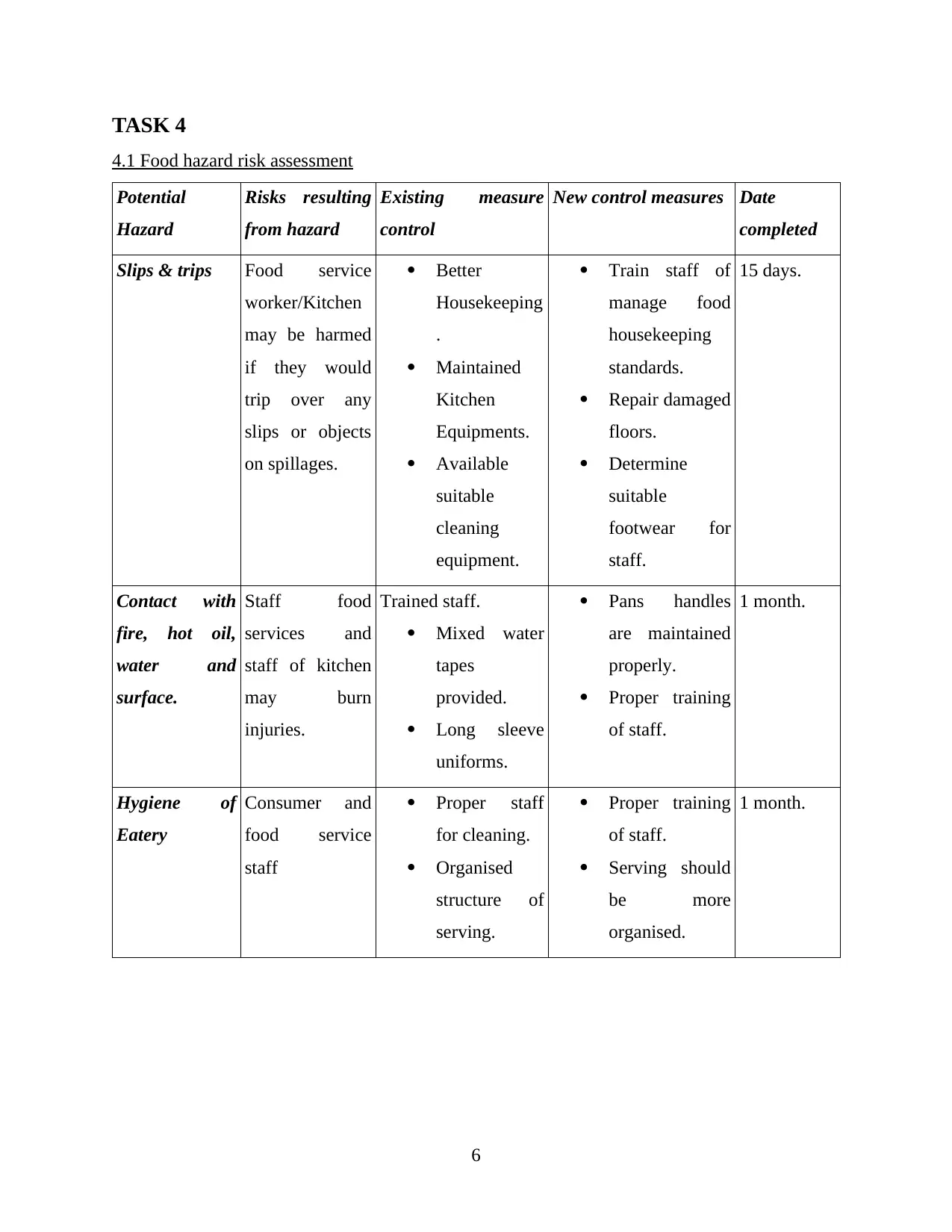
TASK 4
4.1 Food hazard risk assessment
Potential
Hazard
Risks resulting
from hazard
Existing measure
control
New control measures Date
completed
Slips & trips Food service
worker/Kitchen
may be harmed
if they would
trip over any
slips or objects
on spillages.
Better
Housekeeping
.
Maintained
Kitchen
Equipments.
Available
suitable
cleaning
equipment.
Train staff of
manage food
housekeeping
standards.
Repair damaged
floors.
Determine
suitable
footwear for
staff.
15 days.
Contact with
fire, hot oil,
water and
surface.
Staff food
services and
staff of kitchen
may burn
injuries.
Trained staff.
Mixed water
tapes
provided.
Long sleeve
uniforms.
Pans handles
are maintained
properly.
Proper training
of staff.
1 month.
Hygiene of
Eatery
Consumer and
food service
staff
Proper staff
for cleaning.
Organised
structure of
serving.
Proper training
of staff.
Serving should
be more
organised.
1 month.
6
4.1 Food hazard risk assessment
Potential
Hazard
Risks resulting
from hazard
Existing measure
control
New control measures Date
completed
Slips & trips Food service
worker/Kitchen
may be harmed
if they would
trip over any
slips or objects
on spillages.
Better
Housekeeping
.
Maintained
Kitchen
Equipments.
Available
suitable
cleaning
equipment.
Train staff of
manage food
housekeeping
standards.
Repair damaged
floors.
Determine
suitable
footwear for
staff.
15 days.
Contact with
fire, hot oil,
water and
surface.
Staff food
services and
staff of kitchen
may burn
injuries.
Trained staff.
Mixed water
tapes
provided.
Long sleeve
uniforms.
Pans handles
are maintained
properly.
Proper training
of staff.
1 month.
Hygiene of
Eatery
Consumer and
food service
staff
Proper staff
for cleaning.
Organised
structure of
serving.
Proper training
of staff.
Serving should
be more
organised.
1 month.
6
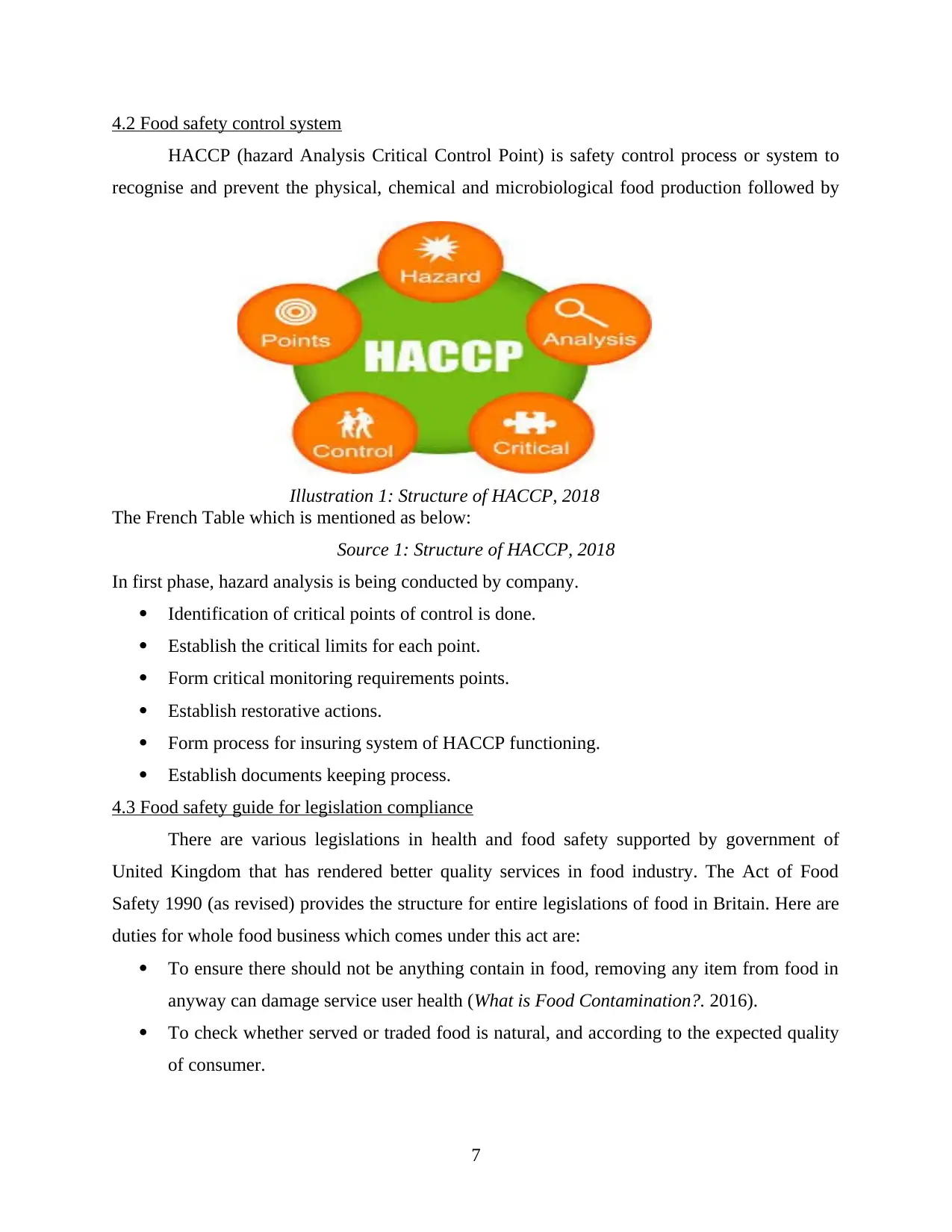
4.2 Food safety control system
HACCP (hazard Analysis Critical Control Point) is safety control process or system to
recognise and prevent the physical, chemical and microbiological food production followed by
The French Table which is mentioned as below:
Source 1: Structure of HACCP, 2018
In first phase, hazard analysis is being conducted by company.
Identification of critical points of control is done.
Establish the critical limits for each point.
Form critical monitoring requirements points.
Establish restorative actions.
Form process for insuring system of HACCP functioning.
Establish documents keeping process.
4.3 Food safety guide for legislation compliance
There are various legislations in health and food safety supported by government of
United Kingdom that has rendered better quality services in food industry. The Act of Food
Safety 1990 (as revised) provides the structure for entire legislations of food in Britain. Here are
duties for whole food business which comes under this act are:
To ensure there should not be anything contain in food, removing any item from food in
anyway can damage service user health (What is Food Contamination?. 2016).
To check whether served or traded food is natural, and according to the expected quality
of consumer.
7
Illustration 1: Structure of HACCP, 2018
HACCP (hazard Analysis Critical Control Point) is safety control process or system to
recognise and prevent the physical, chemical and microbiological food production followed by
The French Table which is mentioned as below:
Source 1: Structure of HACCP, 2018
In first phase, hazard analysis is being conducted by company.
Identification of critical points of control is done.
Establish the critical limits for each point.
Form critical monitoring requirements points.
Establish restorative actions.
Form process for insuring system of HACCP functioning.
Establish documents keeping process.
4.3 Food safety guide for legislation compliance
There are various legislations in health and food safety supported by government of
United Kingdom that has rendered better quality services in food industry. The Act of Food
Safety 1990 (as revised) provides the structure for entire legislations of food in Britain. Here are
duties for whole food business which comes under this act are:
To ensure there should not be anything contain in food, removing any item from food in
anyway can damage service user health (What is Food Contamination?. 2016).
To check whether served or traded food is natural, and according to the expected quality
of consumer.
7
Illustration 1: Structure of HACCP, 2018
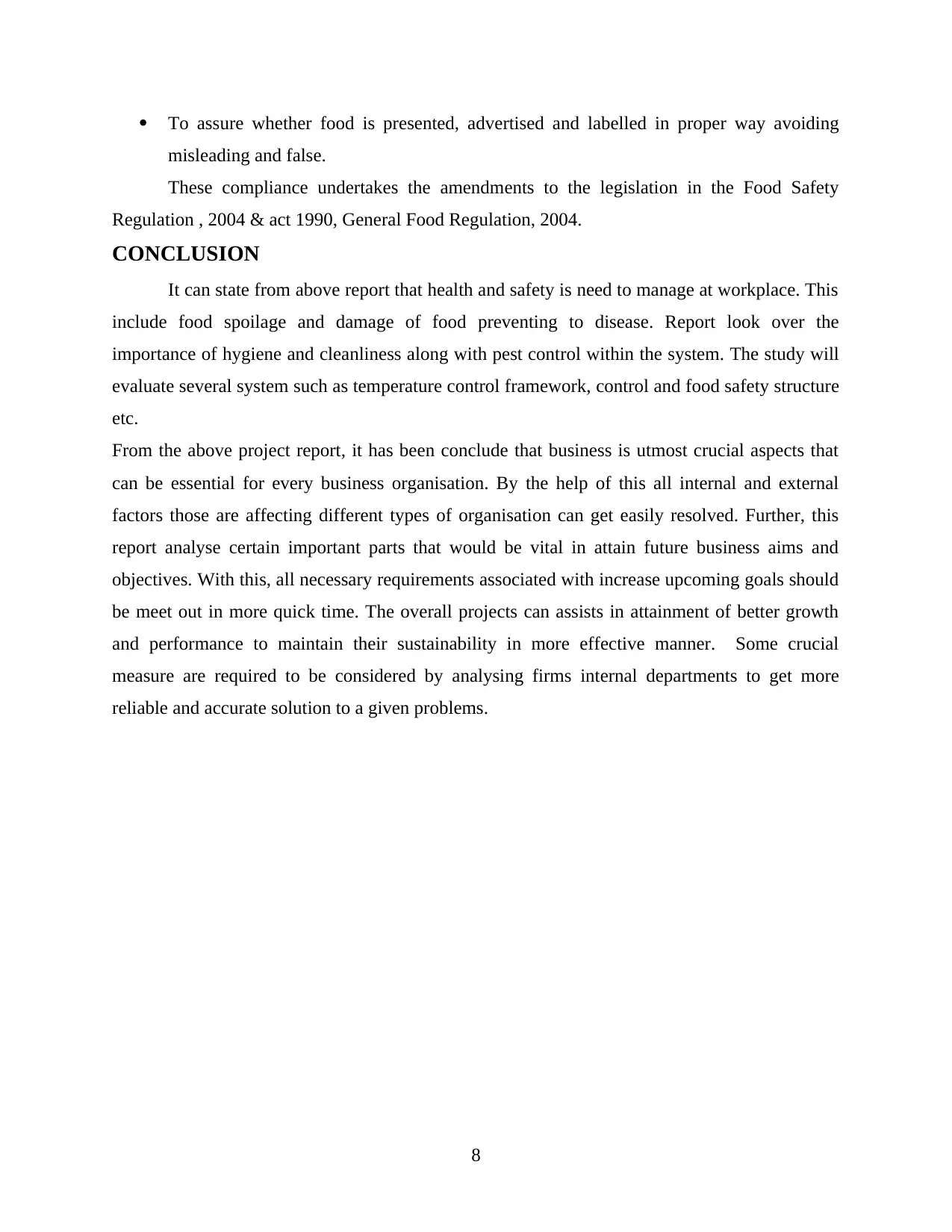
To assure whether food is presented, advertised and labelled in proper way avoiding
misleading and false.
These compliance undertakes the amendments to the legislation in the Food Safety
Regulation , 2004 & act 1990, General Food Regulation, 2004.
CONCLUSION
It can state from above report that health and safety is need to manage at workplace. This
include food spoilage and damage of food preventing to disease. Report look over the
importance of hygiene and cleanliness along with pest control within the system. The study will
evaluate several system such as temperature control framework, control and food safety structure
etc.
From the above project report, it has been conclude that business is utmost crucial aspects that
can be essential for every business organisation. By the help of this all internal and external
factors those are affecting different types of organisation can get easily resolved. Further, this
report analyse certain important parts that would be vital in attain future business aims and
objectives. With this, all necessary requirements associated with increase upcoming goals should
be meet out in more quick time. The overall projects can assists in attainment of better growth
and performance to maintain their sustainability in more effective manner. Some crucial
measure are required to be considered by analysing firms internal departments to get more
reliable and accurate solution to a given problems.
8
misleading and false.
These compliance undertakes the amendments to the legislation in the Food Safety
Regulation , 2004 & act 1990, General Food Regulation, 2004.
CONCLUSION
It can state from above report that health and safety is need to manage at workplace. This
include food spoilage and damage of food preventing to disease. Report look over the
importance of hygiene and cleanliness along with pest control within the system. The study will
evaluate several system such as temperature control framework, control and food safety structure
etc.
From the above project report, it has been conclude that business is utmost crucial aspects that
can be essential for every business organisation. By the help of this all internal and external
factors those are affecting different types of organisation can get easily resolved. Further, this
report analyse certain important parts that would be vital in attain future business aims and
objectives. With this, all necessary requirements associated with increase upcoming goals should
be meet out in more quick time. The overall projects can assists in attainment of better growth
and performance to maintain their sustainability in more effective manner. Some crucial
measure are required to be considered by analysing firms internal departments to get more
reliable and accurate solution to a given problems.
8
Secure Best Marks with AI Grader
Need help grading? Try our AI Grader for instant feedback on your assignments.
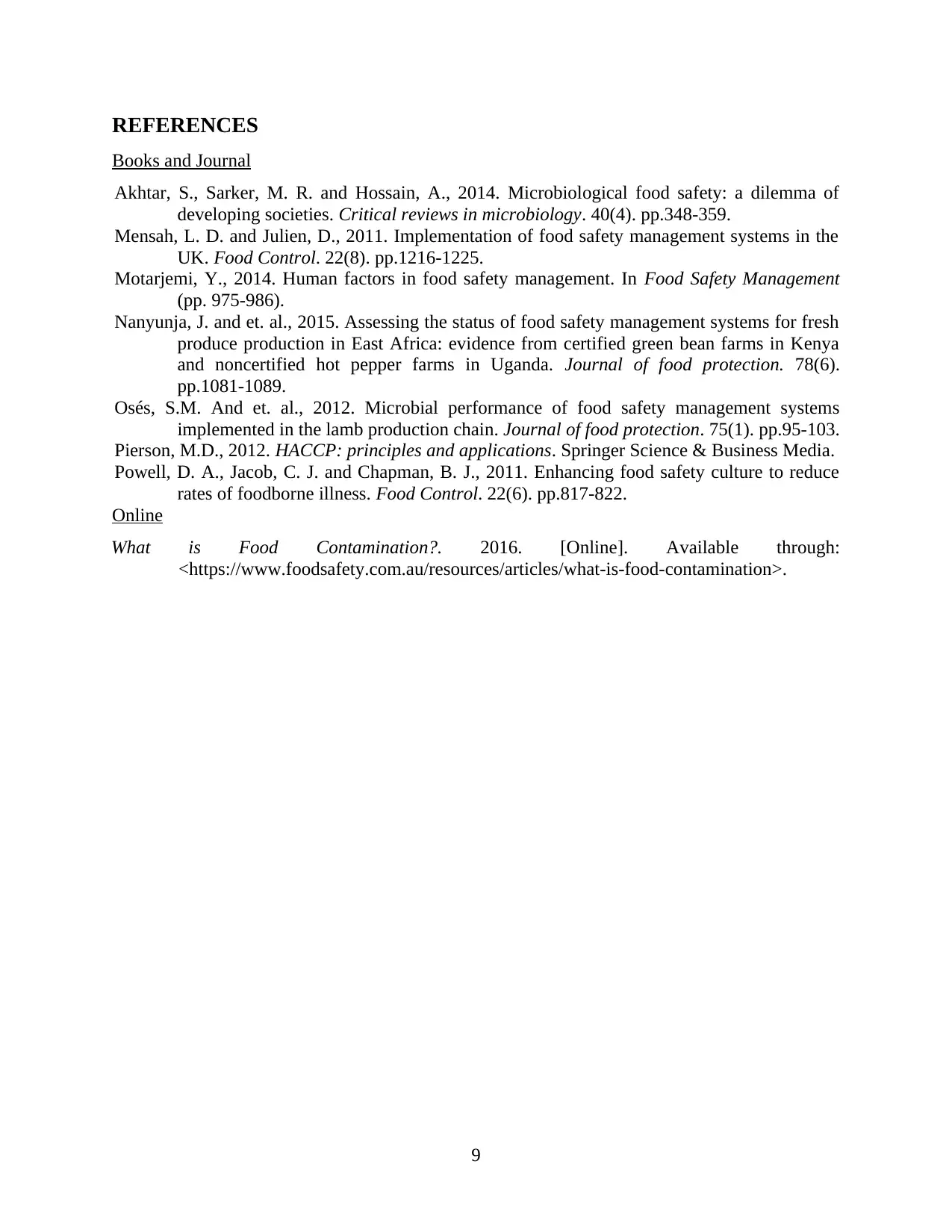
REFERENCES
Books and Journal
Akhtar, S., Sarker, M. R. and Hossain, A., 2014. Microbiological food safety: a dilemma of
developing societies. Critical reviews in microbiology. 40(4). pp.348-359.
Mensah, L. D. and Julien, D., 2011. Implementation of food safety management systems in the
UK. Food Control. 22(8). pp.1216-1225.
Motarjemi, Y., 2014. Human factors in food safety management. In Food Safety Management
(pp. 975-986).
Nanyunja, J. and et. al., 2015. Assessing the status of food safety management systems for fresh
produce production in East Africa: evidence from certified green bean farms in Kenya
and noncertified hot pepper farms in Uganda. Journal of food protection. 78(6).
pp.1081-1089.
Osés, S.M. And et. al., 2012. Microbial performance of food safety management systems
implemented in the lamb production chain. Journal of food protection. 75(1). pp.95-103.
Pierson, M.D., 2012. HACCP: principles and applications. Springer Science & Business Media.
Powell, D. A., Jacob, C. J. and Chapman, B. J., 2011. Enhancing food safety culture to reduce
rates of foodborne illness. Food Control. 22(6). pp.817-822.
Online
What is Food Contamination?. 2016. [Online]. Available through:
<https://www.foodsafety.com.au/resources/articles/what-is-food-contamination>.
9
Books and Journal
Akhtar, S., Sarker, M. R. and Hossain, A., 2014. Microbiological food safety: a dilemma of
developing societies. Critical reviews in microbiology. 40(4). pp.348-359.
Mensah, L. D. and Julien, D., 2011. Implementation of food safety management systems in the
UK. Food Control. 22(8). pp.1216-1225.
Motarjemi, Y., 2014. Human factors in food safety management. In Food Safety Management
(pp. 975-986).
Nanyunja, J. and et. al., 2015. Assessing the status of food safety management systems for fresh
produce production in East Africa: evidence from certified green bean farms in Kenya
and noncertified hot pepper farms in Uganda. Journal of food protection. 78(6).
pp.1081-1089.
Osés, S.M. And et. al., 2012. Microbial performance of food safety management systems
implemented in the lamb production chain. Journal of food protection. 75(1). pp.95-103.
Pierson, M.D., 2012. HACCP: principles and applications. Springer Science & Business Media.
Powell, D. A., Jacob, C. J. and Chapman, B. J., 2011. Enhancing food safety culture to reduce
rates of foodborne illness. Food Control. 22(6). pp.817-822.
Online
What is Food Contamination?. 2016. [Online]. Available through:
<https://www.foodsafety.com.au/resources/articles/what-is-food-contamination>.
9
1 out of 11
Related Documents
Your All-in-One AI-Powered Toolkit for Academic Success.
+13062052269
info@desklib.com
Available 24*7 on WhatsApp / Email
![[object Object]](/_next/static/media/star-bottom.7253800d.svg)
Unlock your academic potential
© 2024 | Zucol Services PVT LTD | All rights reserved.





